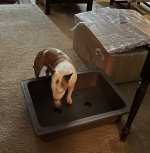A local club member's poor health has forced him to give up bonsai, and we've been asked to try to sell his pots. Almost all are production grade. Examples of the smaller ones can be found on Ebay and elsewhere on the web. However, he has some really big ones that I'm having trouble pricing. Here are some of the pots and dimensions:
Late generation mass produced Yaamaki unglazed shallow oval 28"
Late generation mass produced Yaamaki unglazed rectangle 32"
Unmarked cream glazed shallow oval with crack running from rim to foot 30"
If the pots are used, does this detract from value?
How much do severe structural cracks detract from value?
Late generation mass produced Yaamaki unglazed shallow oval 28"
Late generation mass produced Yaamaki unglazed rectangle 32"
Unmarked cream glazed shallow oval with crack running from rim to foot 30"
If the pots are used, does this detract from value?
How much do severe structural cracks detract from value?

